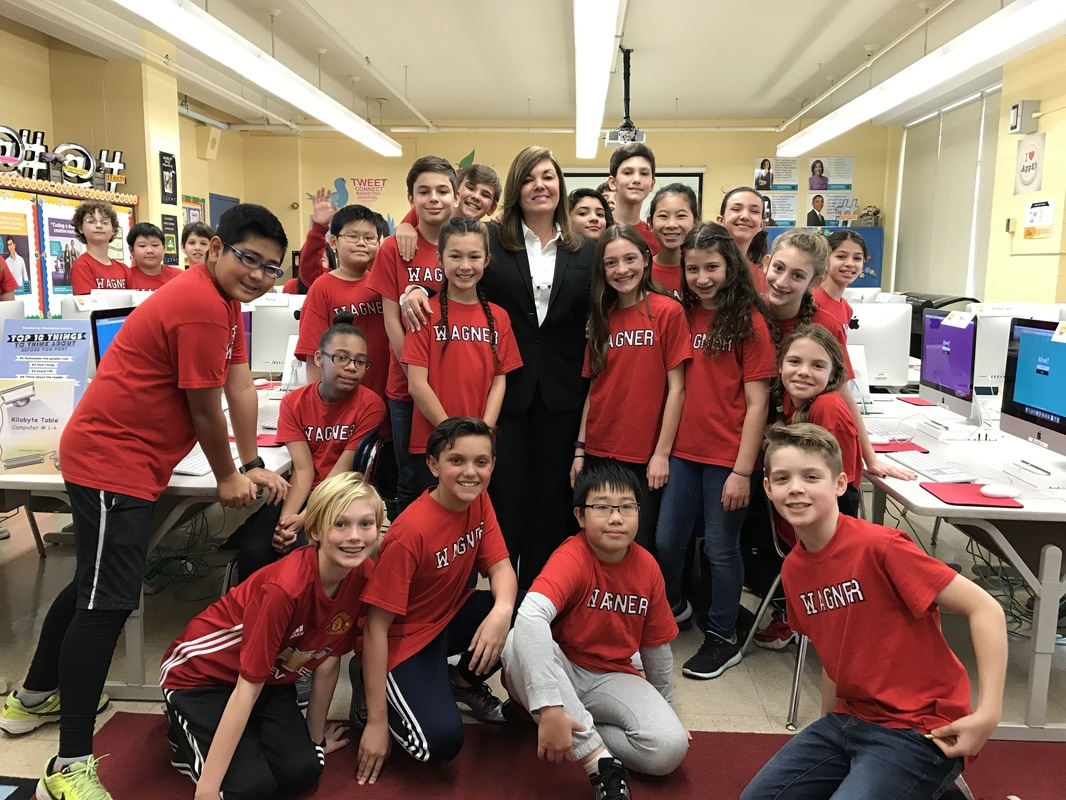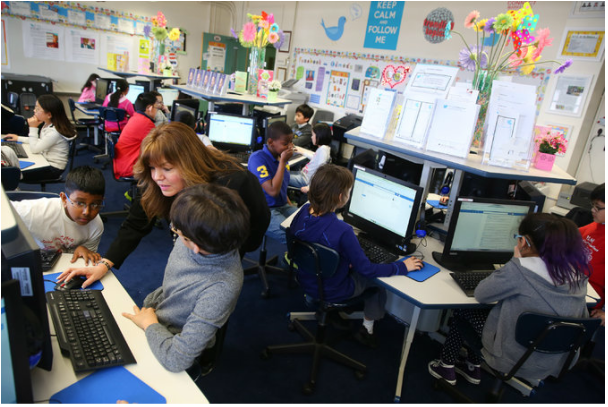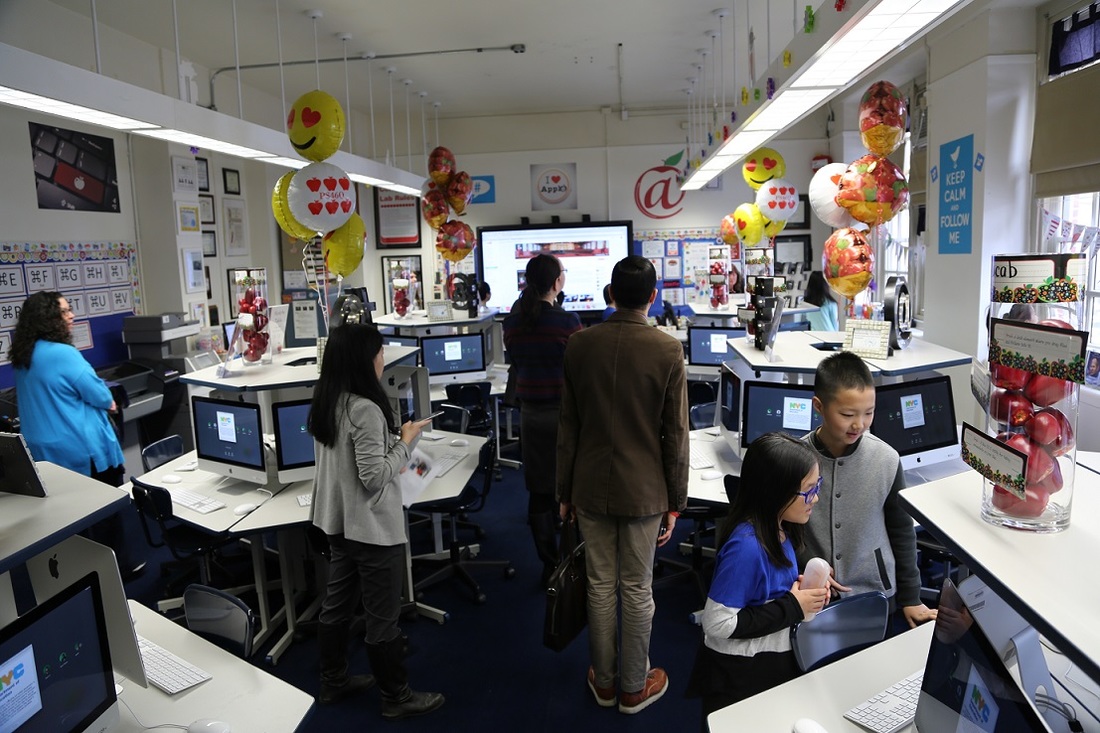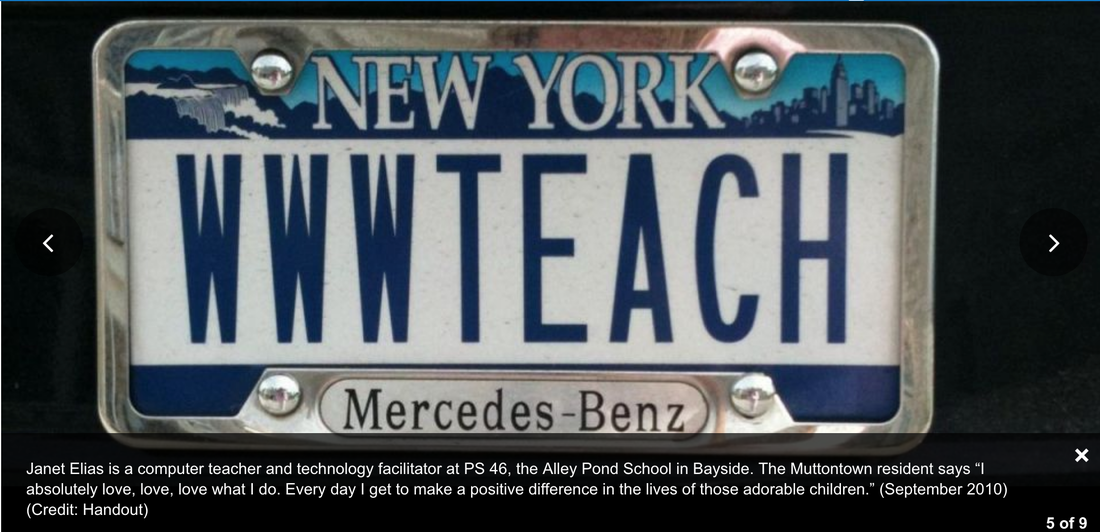MS. ELIAS TECHNOLOGY @KEEPINGUPWIYHTECHNOLOY
MS167 ON THE TODAY SHOW ~ January 25, 2017
Device-free dinners: Bringing families closer together, one meal at a time
Some experts say technology has created a culture of obsession and addiction. TODAY’s Sheinelle Jones shares a look at the partnership between NBC Universal’s parent company Comcast and nonprofit Common Sense Media to try to break that cycle, one dinner at a time. Parents and children alike express what they’ve learned from the simple act of putting their phones, tablets and computers away during mealtime.
Some experts say technology has created a culture of obsession and addiction. TODAY’s Sheinelle Jones shares a look at the partnership between NBC Universal’s parent company Comcast and nonprofit Common Sense Media to try to break that cycle, one dinner at a time. Parents and children alike express what they’ve learned from the simple act of putting their phones, tablets and computers away during mealtime.
More than 80 percent of young people have access to technology, which creates a culture of obsession and addiction according to some experts.
But Comcast, the parent company of NBC Universal partnered with the non-profit Common Sense Media, to try to break the cycle, one meal at a time.
James Steyer, CEO of Common Sense Media said 56 percent of American parents are concerned their kids are addicted to devices, but ironically the average parent in this country spends nine hours a day with media and technology themselves.
Three quarters of american teenagers have access to smartphones, and half of them report being addicted.
An epidemic which some experts say is breaking down communication in families and raising a generation so fully vested in technology that they are unable to imagine a world without it.
Janet Elias teaches six and seventh graders at New York city’s Wagner Middle School. She requires students and their families to engage in device free dinners, a movement launched by common sense media asking families to set aside time every day to connect rather than tech during meal time.
“The parents and the children should be sitting at the dinner table, having conversation, talking about their days,” Elias said.
Research shows family dinners make kids happier and healthier leading to better academic performance, fewer behavioral problems and a lower risk of substance abuse.
Ellis Whiteson, who is age 11 said, “It was amazing the experience was great. I got to talk with my family, I got to hear the funny things that happened in our days.”
Whiteson said his older brother and parents have made device free dinners a reoccurring them, and now has a greater appreciation for their time together.
James Steyer, CEO of Common Sense Media said, “I’s really a message to all of us, to parents and to kids to put the device down and focus on your family.”
The American Academy of Pediatrics is also on board with limiting screen time. They advise that children 2 to 5 years old should be restricted to an hour of high-quality programming. And, children over 6, have consistent limits on the time spent using media.
But Comcast, the parent company of NBC Universal partnered with the non-profit Common Sense Media, to try to break the cycle, one meal at a time.
James Steyer, CEO of Common Sense Media said 56 percent of American parents are concerned their kids are addicted to devices, but ironically the average parent in this country spends nine hours a day with media and technology themselves.
Three quarters of american teenagers have access to smartphones, and half of them report being addicted.
An epidemic which some experts say is breaking down communication in families and raising a generation so fully vested in technology that they are unable to imagine a world without it.
Janet Elias teaches six and seventh graders at New York city’s Wagner Middle School. She requires students and their families to engage in device free dinners, a movement launched by common sense media asking families to set aside time every day to connect rather than tech during meal time.
“The parents and the children should be sitting at the dinner table, having conversation, talking about their days,” Elias said.
Research shows family dinners make kids happier and healthier leading to better academic performance, fewer behavioral problems and a lower risk of substance abuse.
Ellis Whiteson, who is age 11 said, “It was amazing the experience was great. I got to talk with my family, I got to hear the funny things that happened in our days.”
Whiteson said his older brother and parents have made device free dinners a reoccurring them, and now has a greater appreciation for their time together.
James Steyer, CEO of Common Sense Media said, “I’s really a message to all of us, to parents and to kids to put the device down and focus on your family.”
The American Academy of Pediatrics is also on board with limiting screen time. They advise that children 2 to 5 years old should be restricted to an hour of high-quality programming. And, children over 6, have consistent limits on the time spent using media.
In a Queens School, an Early Start on Preparing "Responsible Digital Citizens"
By ALEX VADUKUL APRIL 10, 2014
Janet Elias refers to her students as digital natives, children who have never known a world without computers. She teaches them to search the Internet and create slide-show presentations, and this year she has also added a theme on social media: its applications, its effect on real-world events and the importance of using it safely.
Ms. Elias’s classes at Public School 46 in Bayside, Queens, are not the only ones that touch on social media, but a spokesman for the city’s Education Department said her curriculum was believed to be more complex, involving more programs and drawing on greater student involvement.
Her classroom is filled with arts and crafts celebrating social media. A cutout of a blue bird bears the message, “follow me.” One wall is devoted to the “#trending hashtag of the week.”
“I want to move forward from what we’ve been doing,” she announced recently to fifth graders in her classroom. “I know we’ve all been hashtagging.” She held up a coffee cup and pointed to the message printed on it.
“Can you read that, kids?” The students kneeling before her started nodding.
She read it aloud: “#mydunkin’ ” The children echoed her.
“That’s right!” she replied. “So if I had wanted to, on my way to work this morning, I could have said that I had the best coffee ever, by using this hashtag.”
She was lecturing about Twitter, and the symbol that its users can employ to categorize their tweets, which must be 140 or fewer characters.
All of the school’s classes, from grades one through five, meet with Ms. Elias, the technology teacher, once a week to learn about sites and apps like Facebook, Twitter, Instagram and Snapchat. In the recent class, she talked about the way social media had played a part in President Obama’s campaign and had become a primary source for news during the Winter Olympics, instantly informing people about stray dogs in Sochi, Russia, and a light malfunction in the opening ceremony.
Homework can include composing a tweet in the voice of a book character or successfully posting something to Edmodo, a form of social media, used in classrooms, that Ms. Elias describes as “Facebook with training wheels.” Soon, Ms. Elias said, she would take students outside to take photographs of budding leaves for posting on the school’s Instagram account.
The class presents a possible glimpse into the future, when such lessons may become as commonplace as sex education. It also raises questions — as some parents have pondered — about the appropriate age to introduce a child’s supple mind to the instantaneous universe of social media.
“I don’t approve of social media with kids this young,” said Hong Buist, who has a child in fifth grade. “It’s not necessary.” She suggested that seventh or eighth grade was more appropriate.
“I think they need the skills,” she said, “but I’m not sure they need them that early on.”
Marsha Goldberg, the school’s principal, said she was aware of Ms. Elias’s position in relatively uncharted territory. Other schools may teach social media, she said. “But I don’t think people are doing it to the extent she is. I think she’s on the forefront.” Ms. Goldberg stressed her faith in Ms. Elias’s judgment, but added: “I’m not a hundred percent in favor but I’m also realistic to know it’s there, and you can’t put the genie back in the bottle.”
The number 13 looms large in her teaching. “Before you know it, they’re going to be 13, and they’re going to reach that social media milestone,” she said. “They’re going to be able to sign up for Facebook.”
Kathryn Starace-Saban, who has children in second and fifth grades, said the guidance was important. “Like it or not, it’s going to be part of their daily lives,” she said. “I kind of compare it to sex ed or drug ed. To me it’s the same concept: Get the correct information out there.”
In the classroom, Ms. Elias asked the students to compose a Twitter post, as practice, making a suggestion to the principal. The boys and girls sat at computer stations and started moving their fingers across the monitor screens, counting the length of their messages. There were cries of, “I got a ‘Twoosh,’ ” referring to Ms. Elias’s term for a tweet of 140 characters exactly.
George Iskander, 10, was satisfied with his recommendation that students have fewer tests. “I like social media,” he said. “Without social media, of course, times would be harder. Now we can learn everything about the world. Back then you had to listen more.”
Janet Elias refers to her students as digital natives, children who have never known a world without computers. She teaches them to search the Internet and create slide-show presentations, and this year she has also added a theme on social media: its applications, its effect on real-world events and the importance of using it safely.
Ms. Elias’s classes at Public School 46 in Bayside, Queens, are not the only ones that touch on social media, but a spokesman for the city’s Education Department said her curriculum was believed to be more complex, involving more programs and drawing on greater student involvement.
Her classroom is filled with arts and crafts celebrating social media. A cutout of a blue bird bears the message, “follow me.” One wall is devoted to the “#trending hashtag of the week.”
“I want to move forward from what we’ve been doing,” she announced recently to fifth graders in her classroom. “I know we’ve all been hashtagging.” She held up a coffee cup and pointed to the message printed on it.
“Can you read that, kids?” The students kneeling before her started nodding.
She read it aloud: “#mydunkin’ ” The children echoed her.
“That’s right!” she replied. “So if I had wanted to, on my way to work this morning, I could have said that I had the best coffee ever, by using this hashtag.”
She was lecturing about Twitter, and the symbol that its users can employ to categorize their tweets, which must be 140 or fewer characters.
All of the school’s classes, from grades one through five, meet with Ms. Elias, the technology teacher, once a week to learn about sites and apps like Facebook, Twitter, Instagram and Snapchat. In the recent class, she talked about the way social media had played a part in President Obama’s campaign and had become a primary source for news during the Winter Olympics, instantly informing people about stray dogs in Sochi, Russia, and a light malfunction in the opening ceremony.
Homework can include composing a tweet in the voice of a book character or successfully posting something to Edmodo, a form of social media, used in classrooms, that Ms. Elias describes as “Facebook with training wheels.” Soon, Ms. Elias said, she would take students outside to take photographs of budding leaves for posting on the school’s Instagram account.
The class presents a possible glimpse into the future, when such lessons may become as commonplace as sex education. It also raises questions — as some parents have pondered — about the appropriate age to introduce a child’s supple mind to the instantaneous universe of social media.
“I don’t approve of social media with kids this young,” said Hong Buist, who has a child in fifth grade. “It’s not necessary.” She suggested that seventh or eighth grade was more appropriate.
“I think they need the skills,” she said, “but I’m not sure they need them that early on.”
Marsha Goldberg, the school’s principal, said she was aware of Ms. Elias’s position in relatively uncharted territory. Other schools may teach social media, she said. “But I don’t think people are doing it to the extent she is. I think she’s on the forefront.” Ms. Goldberg stressed her faith in Ms. Elias’s judgment, but added: “I’m not a hundred percent in favor but I’m also realistic to know it’s there, and you can’t put the genie back in the bottle.”
The number 13 looms large in her teaching. “Before you know it, they’re going to be 13, and they’re going to reach that social media milestone,” she said. “They’re going to be able to sign up for Facebook.”
Kathryn Starace-Saban, who has children in second and fifth grades, said the guidance was important. “Like it or not, it’s going to be part of their daily lives,” she said. “I kind of compare it to sex ed or drug ed. To me it’s the same concept: Get the correct information out there.”
In the classroom, Ms. Elias asked the students to compose a Twitter post, as practice, making a suggestion to the principal. The boys and girls sat at computer stations and started moving their fingers across the monitor screens, counting the length of their messages. There were cries of, “I got a ‘Twoosh,’ ” referring to Ms. Elias’s term for a tweet of 140 characters exactly.
George Iskander, 10, was satisfied with his recommendation that students have fewer tests. “I like social media,” he said. “Without social media, of course, times would be harder. Now we can learn everything about the world. Back then you had to listen more.”
THE QUEENS COURIER
Bayside school gets $100K worth of Apple computers in new technology lab
By Alina Suriel / [email protected] / Wednesday, February 17, 2016
By Alina Suriel / [email protected] / Wednesday, February 17, 2016
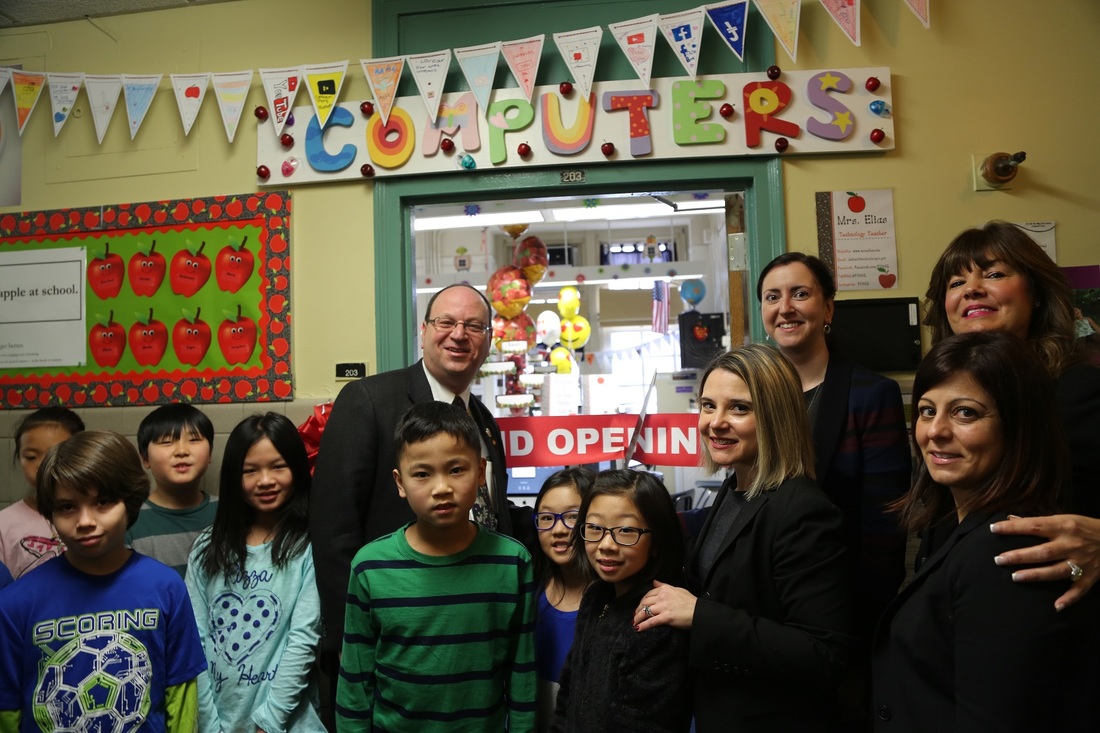
A Bayside elementary school is leading the pack when it comes to technology education and they have a brand-new computer lab to prove it.
P.S. 46 unveiled a lab full of Apple iMac desktop computers as part of their ongoing emphasis on digital and technology education. The classroom features 36 desktop computers and all new furnishings. It’s decorated with a technology and social media theme, including a section of books honoring computer pioneers such as Bill Gates and a scattering of social media vocabulary words posted on the walls. The entire project cost a total of $100,000.
School Principal Stamo Karalazarides said the school aims to enhance student knowledge and experiences with technology by upgrading its resources.
“Technology is changing faster than any other career or any other subject area in this whole world,” Karalazarides said.
According to technology facilitator Janet Elias, this is the fourth upgrade for the lab but the first time the school will use Apple computers.
Elias said early computer education ensures that children are college- and career-ready later in life.The teacher has a website with features explaining the features of the new Mac operating system so that children can know how to use both Macs and PCs by graduation. Elias also teaches extensive computer coding classes and social media etiquette to help students navigate the online world that many begin to interact with in their early teen years.
“Innovative education goes far beyond how to use new tools,” Elias said. “It requires us to rethink how we teach and learn, and it calls on us to re-engineer our classrooms in the growing digital age.”
The project was funded by former Councilman Mark Weprin, who resigned last year. Weprin’s successor, Barry Grodenchik, was at the school to cut the ribbon for the lab’s grand opening.
“This is the nicest computer lab I have seen in any New York City school, bar none,” Grodenchik said. “Just absolutely gorgeous.”
Assemblywoman Nily Rozic was also at the opening to admire the new classroom at P.S. 46.
“Classrooms are the hub of innovation and where kids learn the most at their earliest,” Rozic said, “so anything we can do to support that is great.”
THE QUEENS COURIER
Three Queens elementary schools receive Blue Ribbon Award
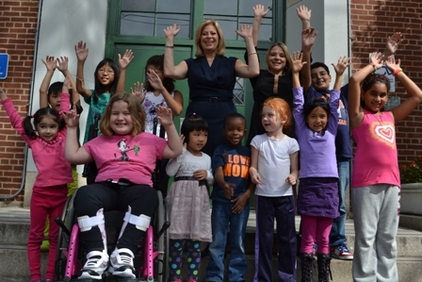
By Melissa Chan
Wednesday, September 25th, 2013
The coveted federal Blue Ribbon award will go to three Queens elementary schools this year, U.S. education officials announced early this week.
P.S. 46 in Oakland Gardens, P.S. 66 in Richmond Hill and P.S. 221 in Little Neck earned their prestigious titles on September 24.
The honor is given to public and private schools that have demonstrated significant student achievement, education officials said. It is based on overall academic excellence or improvement.
“We’re pretty excited,” said Principal Marsha Goldberg of P.S. 46. “The students realize the impact as much as the adults do. This is their expectation. To them, it’s another day at school.”
Principal Patricia Bullard of P.S. 221 said her school’s award was achieved through “the hard work of our conscientious students, dedication of our talented staff and support of our parents.”
“I am extremely proud of our entire school community for achieving this national distinction,” she said in a statement. “P.S. 221 is truly a special place.”
Over in Richmond Hill, P.S. 66 was also beaming with pride.
“I’ve been in this community as a teacher since 1976,” said Principal Phyllis Leinwand. “On a personal level, I’m very proud, having been in this area for nearly four decades, that this amazing accolade is being shared by the south Queens community.”
The U.S. Department of Education named 286 schools in the country this year as Blue Ribbon institutions. Award recipients also include two schools in Brooklyn and one in Manhattan.
“Excellence in education matters and we should honor the schools that are leading the way to prepare students for success in college and careers,” said U.S. Secretary of Education Arne Duncan.
“National Blue Ribbon schools represent examples of educational excellence, and their work reflects the belief that every child in America deserves a world-class education,” Duncan continued.
The Blue Ribbon honorees will be celebrated in November at an awards ceremony in Washington, D.C.
Wednesday, September 25th, 2013
The coveted federal Blue Ribbon award will go to three Queens elementary schools this year, U.S. education officials announced early this week.
P.S. 46 in Oakland Gardens, P.S. 66 in Richmond Hill and P.S. 221 in Little Neck earned their prestigious titles on September 24.
The honor is given to public and private schools that have demonstrated significant student achievement, education officials said. It is based on overall academic excellence or improvement.
“We’re pretty excited,” said Principal Marsha Goldberg of P.S. 46. “The students realize the impact as much as the adults do. This is their expectation. To them, it’s another day at school.”
Principal Patricia Bullard of P.S. 221 said her school’s award was achieved through “the hard work of our conscientious students, dedication of our talented staff and support of our parents.”
“I am extremely proud of our entire school community for achieving this national distinction,” she said in a statement. “P.S. 221 is truly a special place.”
Over in Richmond Hill, P.S. 66 was also beaming with pride.
“I’ve been in this community as a teacher since 1976,” said Principal Phyllis Leinwand. “On a personal level, I’m very proud, having been in this area for nearly four decades, that this amazing accolade is being shared by the south Queens community.”
The U.S. Department of Education named 286 schools in the country this year as Blue Ribbon institutions. Award recipients also include two schools in Brooklyn and one in Manhattan.
“Excellence in education matters and we should honor the schools that are leading the way to prepare students for success in college and careers,” said U.S. Secretary of Education Arne Duncan.
“National Blue Ribbon schools represent examples of educational excellence, and their work reflects the belief that every child in America deserves a world-class education,” Duncan continued.
The Blue Ribbon honorees will be celebrated in November at an awards ceremony in Washington, D.C.
NYCDOE
U.S. Secretary of Education Arne Duncan Announces 286 National Blue Ribbon Schools for 2013
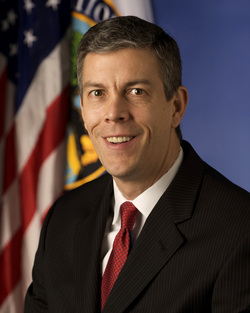
Video Clip
U.S. Secretary of Education Arne Duncan today announced 286 schools as the 2013 cohort of National Blue Ribbon Schools, based on their overall academic excellence or their progress in improving student academic achievement. Secretary Duncan made this year's announcement live via the Department's USTREAM channel http://www.ustream.tv/recorded/39189722, viewed by recognized principals, teachers, and students assembled across the country.
The Department will honor 236 public and 50 private schools at a recognition ceremony on Nov. 18-19 in Washington, D.C. In its 31-year history, the National Blue Ribbon Schools Program has bestowed this coveted award on nearly 7,500 of America's schools.
"Excellence in education matters and we should honor the schools that are leading the way to prepare students for success in college and careers," said Secretary Duncan. "National Blue Ribbon schools represent examples of educational excellence, and their work reflects the belief that every child in America deserves a world-class education."
The National Blue Ribbon Schools award honors public and private elementary, middle, and high schools where students perform at very high levels or where significant improvements are being made in students' levels of achievement.
The program recognizes schools in one of two performance categories. The first category is "Exemplary High Performing," in which schools are recognized among their state's highest performing schools, as measured by state assessments or nationally-normed tests. The second category is "Exemplary Improving," in which schools that have at least 40 percent of their students from disadvantaged backgrounds demonstrate the most progress in improving student achievement levels as measured by state assessments or nationally-normed tests.
To select National Blue Ribbon Schools, the Department requested nominations from the top education official in every state, the District of Columbia, Puerto Rico, the Department of Defense Education Activity, and the Bureau of Indian Education. The Council for American Private Education (CAPE) nominates private schools. A total of 420 schools nationwide may be nominated, with allocations determined by the numbers of K-12 students and schools in each jurisdiction. The Secretary of Education invites nominated schools to submit an application for possible recognition as a National Blue Ribbon School.
Note to Editors: A list of the 2013 National Blue Ribbon Schools is available at http://www2.ed.gov/programs/nclbbrs/.
U.S. Secretary of Education Arne Duncan today announced 286 schools as the 2013 cohort of National Blue Ribbon Schools, based on their overall academic excellence or their progress in improving student academic achievement. Secretary Duncan made this year's announcement live via the Department's USTREAM channel http://www.ustream.tv/recorded/39189722, viewed by recognized principals, teachers, and students assembled across the country.
The Department will honor 236 public and 50 private schools at a recognition ceremony on Nov. 18-19 in Washington, D.C. In its 31-year history, the National Blue Ribbon Schools Program has bestowed this coveted award on nearly 7,500 of America's schools.
"Excellence in education matters and we should honor the schools that are leading the way to prepare students for success in college and careers," said Secretary Duncan. "National Blue Ribbon schools represent examples of educational excellence, and their work reflects the belief that every child in America deserves a world-class education."
The National Blue Ribbon Schools award honors public and private elementary, middle, and high schools where students perform at very high levels or where significant improvements are being made in students' levels of achievement.
The program recognizes schools in one of two performance categories. The first category is "Exemplary High Performing," in which schools are recognized among their state's highest performing schools, as measured by state assessments or nationally-normed tests. The second category is "Exemplary Improving," in which schools that have at least 40 percent of their students from disadvantaged backgrounds demonstrate the most progress in improving student achievement levels as measured by state assessments or nationally-normed tests.
To select National Blue Ribbon Schools, the Department requested nominations from the top education official in every state, the District of Columbia, Puerto Rico, the Department of Defense Education Activity, and the Bureau of Indian Education. The Council for American Private Education (CAPE) nominates private schools. A total of 420 schools nationwide may be nominated, with allocations determined by the numbers of K-12 students and schools in each jurisdiction. The Secretary of Education invites nominated schools to submit an application for possible recognition as a National Blue Ribbon School.
Note to Editors: A list of the 2013 National Blue Ribbon Schools is available at http://www2.ed.gov/programs/nclbbrs/.
THE QUEENS COURIER
Cards for Christmas: Students help ill boy reach record
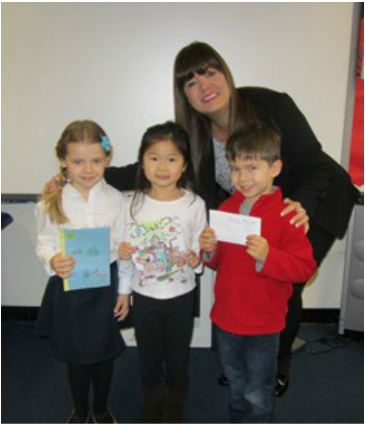
By Melissa Chan Thursday, December 27th, 2012
Bayside youngsters have risen to the challenge of fulfilling a terminally ill Kentucky boy’s dying wish.
Students at P.S. 46 have joined a worldwide initiative to help nine-year-old Dalton Dingus reach a world record for receiving the most holiday cards.
Dingus, who is in stage 4 of cystic fibrosis, skyrocketed to national stardom this month, when thousands of cards poured into his Salyersville home from international and countrywide well-wishers supporting his goal.
More than 1,000 holiday cards have been mailed to Dingus from students of every grade at P.S. 46, according to Janet Elias, the school’s technology facilitator.
“It was overwhelming – the beautiful things they wrote to him. They all told him to be strong and to believe in Christmas miracles. I wanted to cry,” Elias said.
Students in kindergarten through fifth grade designed 1,056 holiday cards on the computer, and then printed and mailed the compassionate creations to Dingus on December 17.
“It really means that these kids are so incredible. They have so much love to give,” said Elias, who added their next project is to fashion snowflakes to hang in the Sandy Hook Elementary school’s students’ new academic home.
Guinness World Records said it “currently does not monitor a category” for the task Dingus is tackling, but added the record on track was about 205,000.
According to the “Cards for Dalton” Facebook page, close to 130,000 cards had been received as of press time, with still plenty left to be counted.
The Dingus family is accepting cards until December 31. They can be sent to Dalton Dingus at HC 62 Box 1249 in Salyersville, KY 41465.
Bayside youngsters have risen to the challenge of fulfilling a terminally ill Kentucky boy’s dying wish.
Students at P.S. 46 have joined a worldwide initiative to help nine-year-old Dalton Dingus reach a world record for receiving the most holiday cards.
Dingus, who is in stage 4 of cystic fibrosis, skyrocketed to national stardom this month, when thousands of cards poured into his Salyersville home from international and countrywide well-wishers supporting his goal.
More than 1,000 holiday cards have been mailed to Dingus from students of every grade at P.S. 46, according to Janet Elias, the school’s technology facilitator.
“It was overwhelming – the beautiful things they wrote to him. They all told him to be strong and to believe in Christmas miracles. I wanted to cry,” Elias said.
Students in kindergarten through fifth grade designed 1,056 holiday cards on the computer, and then printed and mailed the compassionate creations to Dingus on December 17.
“It really means that these kids are so incredible. They have so much love to give,” said Elias, who added their next project is to fashion snowflakes to hang in the Sandy Hook Elementary school’s students’ new academic home.
Guinness World Records said it “currently does not monitor a category” for the task Dingus is tackling, but added the record on track was about 205,000.
According to the “Cards for Dalton” Facebook page, close to 130,000 cards had been received as of press time, with still plenty left to be counted.
The Dingus family is accepting cards until December 31. They can be sent to Dalton Dingus at HC 62 Box 1249 in Salyersville, KY 41465.
THE QUEENS COURIER
Bayside school P.S. 46 leads district in progress reports
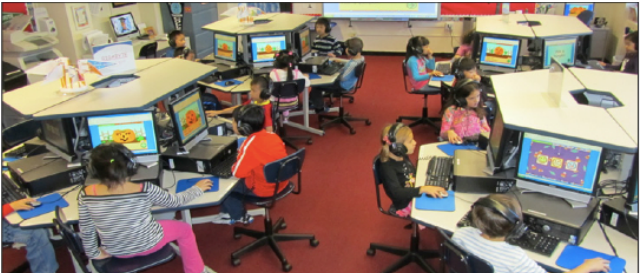
Wednesday, November 2nd, 2011
By:Melissa Chan
Another “A” is in the bag for P.S. 46.
According to progress reports released by the Department of Education (DOE), the Alley Pond School in Bayside received another “A” this year, making it the number one school in the leading district in Queens.
District 26 — which P.S. 46 falls under — was the highest academically performing district in the borough, according to the report. Serving the northeast area, the district covers Bayside, Oakland Gardens, Fresh Meadows, Douglaston, Little Neck, Glen Oaks, Floral Park, Bellerose, Jamaica Estates, Jamaica Hills, Hillcrest and parts of both Hollis Hills and Holliswood.
The annual progress reports award public schools letter grades from “A” to “F” based on student progress and performance, attendance and school environment. They also take into account academic progress made with students with disabilities and, new this year, the progress of black and Latino male students.
“I’m really happy. We’re very proud of all the hard work by the administration, the teachers, school staff, parents and students. It’s a very good feeling,” said Principal Marsha Goldberg.
The straight-A school scored an overall total of 83.7 percent, placing it in the top 98th percentile in the city. Not only is the school a top contender in the borough, it ranked 16th citywide out of 1,148 elementary and middle schools.
“It just validates that we’re on the right track. We’re doing what we think is right, and it appears to be working,” said Goldberg, who celebrates her 10th anniversary as principal this year.
The school has maintained its good standing and a straight-A rating since the grading system began in 2007.
But what really sets the school apart from others is its strength and background in special education. Goldberg previously served as the District 26 supervisor for special education.
P.S. 46 was one of the first schools in the district to have “inclusion” classes, and it currently accommodates a substantial special education population. In those classes, children receiving special education services are integrated into regular classes with two teachers and two aides working together.
In addition to a gymnasium, library and auditorium with a wheel-chair accessible stage, the school has an entire corridor dedicated to support services for those with special needs — including an elevator and a physical therapy room filled with professional-grade equipment.
Overall, Goldberg said the school’s success lies in working hard and working together.
“It really comes from having an open door policy and working side by side with the school community,” she said. “We’re really supportive of each other.”
By:Melissa Chan
Another “A” is in the bag for P.S. 46.
According to progress reports released by the Department of Education (DOE), the Alley Pond School in Bayside received another “A” this year, making it the number one school in the leading district in Queens.
District 26 — which P.S. 46 falls under — was the highest academically performing district in the borough, according to the report. Serving the northeast area, the district covers Bayside, Oakland Gardens, Fresh Meadows, Douglaston, Little Neck, Glen Oaks, Floral Park, Bellerose, Jamaica Estates, Jamaica Hills, Hillcrest and parts of both Hollis Hills and Holliswood.
The annual progress reports award public schools letter grades from “A” to “F” based on student progress and performance, attendance and school environment. They also take into account academic progress made with students with disabilities and, new this year, the progress of black and Latino male students.
“I’m really happy. We’re very proud of all the hard work by the administration, the teachers, school staff, parents and students. It’s a very good feeling,” said Principal Marsha Goldberg.
The straight-A school scored an overall total of 83.7 percent, placing it in the top 98th percentile in the city. Not only is the school a top contender in the borough, it ranked 16th citywide out of 1,148 elementary and middle schools.
“It just validates that we’re on the right track. We’re doing what we think is right, and it appears to be working,” said Goldberg, who celebrates her 10th anniversary as principal this year.
The school has maintained its good standing and a straight-A rating since the grading system began in 2007.
But what really sets the school apart from others is its strength and background in special education. Goldberg previously served as the District 26 supervisor for special education.
P.S. 46 was one of the first schools in the district to have “inclusion” classes, and it currently accommodates a substantial special education population. In those classes, children receiving special education services are integrated into regular classes with two teachers and two aides working together.
In addition to a gymnasium, library and auditorium with a wheel-chair accessible stage, the school has an entire corridor dedicated to support services for those with special needs — including an elevator and a physical therapy room filled with professional-grade equipment.
Overall, Goldberg said the school’s success lies in working hard and working together.
“It really comes from having an open door policy and working side by side with the school community,” she said. “We’re really supportive of each other.”
THE QUEENS COURIER
Jets deliver teaching tool to school
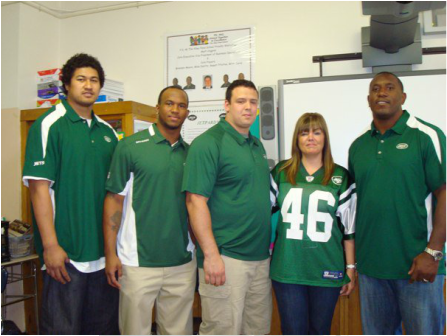
Before they can deliver a Super Bowl to the city, members of the New York Jets delivered a better education to one Queens school.
Gang Green came together with Tequipment, a learning technology provider, to donate 13 SMARTBoards to P.S. 46, The Alley Pond School, on Friday, May 21.
Matt Higgins, Jets executive vice president of business operations, said that SMARTBoards not only facilitate learning in students, it also levels the playing field for students with special needs.
“These boards allow students with special needs to sit in with the other children,” said Higgins, who is also a former student of Alley Pond. “For me, it is a gift to be able to give back to an institution that gave so much to me.”
Higgins brought along current Jets Brandon Moore, Mike DeVito, Ropati Pitoitua and Britt Davis to help deliver the boards and to participate in a demonstration. The Jets were pitted against students in a football trivia game called, “Jet-pardy,” which the students won handily.
Janet Elias, Alley Pond’s tech facilitator, has been working with SMARTBoards for about five years and believes that this technology allows for nonstop learning in a fun environment that kids can really enjoy.
“Everyday this technology keeps the students engaged in learning,” said Elias. “This is the pencil and paper of our time and the kids just love it.”
SMARTBoards are interactive whiteboards that can be used as projectors, enlarged computer screens and can be “written” on by fingers big and small. The complete multimedia center allows students to see, hear and participate in their teacher’s lesson.
Keith Elgart, chief executive officer of Tequipment, said that SMARTBoards help to make the learning experience less passive and gives students a resource to greatly increase their capabilities.
“Children are active and engaged with their work when using these Boards,” said Elgart. “We’ve been providing technologies that transform classrooms and the way students learn and educators teach since our inception, so we were thrilled when they Jets reached out to us.”
The relationship between the Jets and Tequipment was facilitated by PENCIL Partnership Program, which builds and supports relationships between the private sector and school principals.
The Jets figure that their partnership with Tequipment can go beyond Alley Pond and benefit other schools all over the metropolitan area.
“Through our partnership with Tequipment, we are able to provide not only more boards to P.S. 46, but will soon be able to offer to other schools around the region,” said Higgins.
By Steve [email protected]
Gang Green came together with Tequipment, a learning technology provider, to donate 13 SMARTBoards to P.S. 46, The Alley Pond School, on Friday, May 21.
Matt Higgins, Jets executive vice president of business operations, said that SMARTBoards not only facilitate learning in students, it also levels the playing field for students with special needs.
“These boards allow students with special needs to sit in with the other children,” said Higgins, who is also a former student of Alley Pond. “For me, it is a gift to be able to give back to an institution that gave so much to me.”
Higgins brought along current Jets Brandon Moore, Mike DeVito, Ropati Pitoitua and Britt Davis to help deliver the boards and to participate in a demonstration. The Jets were pitted against students in a football trivia game called, “Jet-pardy,” which the students won handily.
Janet Elias, Alley Pond’s tech facilitator, has been working with SMARTBoards for about five years and believes that this technology allows for nonstop learning in a fun environment that kids can really enjoy.
“Everyday this technology keeps the students engaged in learning,” said Elias. “This is the pencil and paper of our time and the kids just love it.”
SMARTBoards are interactive whiteboards that can be used as projectors, enlarged computer screens and can be “written” on by fingers big and small. The complete multimedia center allows students to see, hear and participate in their teacher’s lesson.
Keith Elgart, chief executive officer of Tequipment, said that SMARTBoards help to make the learning experience less passive and gives students a resource to greatly increase their capabilities.
“Children are active and engaged with their work when using these Boards,” said Elgart. “We’ve been providing technologies that transform classrooms and the way students learn and educators teach since our inception, so we were thrilled when they Jets reached out to us.”
The relationship between the Jets and Tequipment was facilitated by PENCIL Partnership Program, which builds and supports relationships between the private sector and school principals.
The Jets figure that their partnership with Tequipment can go beyond Alley Pond and benefit other schools all over the metropolitan area.
“Through our partnership with Tequipment, we are able to provide not only more boards to P.S. 46, but will soon be able to offer to other schools around the region,” said Higgins.
By Steve [email protected]
ABC NEWS
Schools prepare to stop flu spread
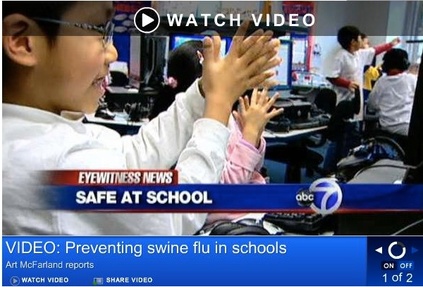
By Art McFarlandNEW YORK (WABC) --
After the H1N1 flu shuttered many schools for weeks last year, officials are taking extra steps to prevent that from happening again this year. But what can be done to prevent the spread of germs?
Before and after students at PS 46 use the computer lab, they use hand sanitizers.
"And we're going to continue following the proper protocols that were set by the DOE and the DOH to make sure that our children are healthy," principal Marsha Goldberg said.
The protocols are part of the city's Open School Policy, which says that health officials do not plan to close schools that experience influenza activity and that schools will instead pursue measures designed to slow transmission while classes and activities continue. Some PS 46 parents are comfortable with the policy, to a point.
"I think that when a large percent of the population of the school becomes infected, then we don't want to spread it around anymore, and the school should be closed," parent Susan Delli Paoli said.
Click here to view the complete special, Swine Flu: A Dose of Reality
Since the policy last spring of closing some schools, more is known about the H1N1 virus.
"What has happened with H1N1, and we have been very fortunate, in that most of the infections that have occurred, particularly in younger people, have been mild infections," said Dr. James Rahal, an infectious disease expert at New York Hospital-Queens.
He says the severity of the disease among the children who are infected is the number one factor in determining whether or not a school should be closed.
Flu-like illnesses at individual schools will be posted online, each day. The Department of Health says that if at least 15 kids in a school see the school nurse in one day, a doctor or supervising nurse will visit the school to assess the situation.
Experts say offices should also take precautions and develop plans for sick calls.
"Whether it's a school, child or an office worker, you will try to prevent severe disease in as many people as possible," Dr. Rahal said.
After the H1N1 flu shuttered many schools for weeks last year, officials are taking extra steps to prevent that from happening again this year. But what can be done to prevent the spread of germs?
Before and after students at PS 46 use the computer lab, they use hand sanitizers.
"And we're going to continue following the proper protocols that were set by the DOE and the DOH to make sure that our children are healthy," principal Marsha Goldberg said.
The protocols are part of the city's Open School Policy, which says that health officials do not plan to close schools that experience influenza activity and that schools will instead pursue measures designed to slow transmission while classes and activities continue. Some PS 46 parents are comfortable with the policy, to a point.
"I think that when a large percent of the population of the school becomes infected, then we don't want to spread it around anymore, and the school should be closed," parent Susan Delli Paoli said.
Click here to view the complete special, Swine Flu: A Dose of Reality
Since the policy last spring of closing some schools, more is known about the H1N1 virus.
"What has happened with H1N1, and we have been very fortunate, in that most of the infections that have occurred, particularly in younger people, have been mild infections," said Dr. James Rahal, an infectious disease expert at New York Hospital-Queens.
He says the severity of the disease among the children who are infected is the number one factor in determining whether or not a school should be closed.
Flu-like illnesses at individual schools will be posted online, each day. The Department of Health says that if at least 15 kids in a school see the school nurse in one day, a doctor or supervising nurse will visit the school to assess the situation.
Experts say offices should also take precautions and develop plans for sick calls.
"Whether it's a school, child or an office worker, you will try to prevent severe disease in as many people as possible," Dr. Rahal said.
THE QUEENS COURIER
School Shows New Lab
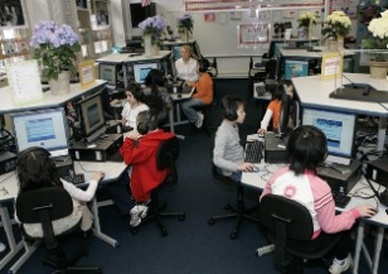
Wednesday, April 9, 2008 7:56 PM
Councilmember David Weprin recently had the chance to see kids at the Alley Pond School in Bayside hard at work in their new computer lab. The school, P.S. 46, had officially opened the lab on February 29, 2008, but held a second ceremony recently to celebrate its completion.
Equipped with 36 state-of-the-art computers and a SMART Board, the lab is designed with the computers in clusters, rather than in rows, as the previous lab had been setup. The new design is more conducive to groups, said P.S. 46 Principal Marsha Goldberg.
Weprin had allocated $150,000 in funds for the project in the budget three years ago, but the process was held up when school officials fought for the design they had envisioned, Goldberg said.
“I learned a lot about red tape,” said the school’s computer instructor Janet Elias.
Eight-year-old Shirley Chen of Bayside didn’t seem to mind the wait - the computer-savvy kid happily completed an Internet-safety program during Weprin’s visit on Friday, April 4.
Councilmember David Weprin recently had the chance to see kids at the Alley Pond School in Bayside hard at work in their new computer lab. The school, P.S. 46, had officially opened the lab on February 29, 2008, but held a second ceremony recently to celebrate its completion.
Equipped with 36 state-of-the-art computers and a SMART Board, the lab is designed with the computers in clusters, rather than in rows, as the previous lab had been setup. The new design is more conducive to groups, said P.S. 46 Principal Marsha Goldberg.
Weprin had allocated $150,000 in funds for the project in the budget three years ago, but the process was held up when school officials fought for the design they had envisioned, Goldberg said.
“I learned a lot about red tape,” said the school’s computer instructor Janet Elias.
Eight-year-old Shirley Chen of Bayside didn’t seem to mind the wait - the computer-savvy kid happily completed an Internet-safety program during Weprin’s visit on Friday, April 4.
THE QUEENS COURIER
Kindergarten Students Training on Computers
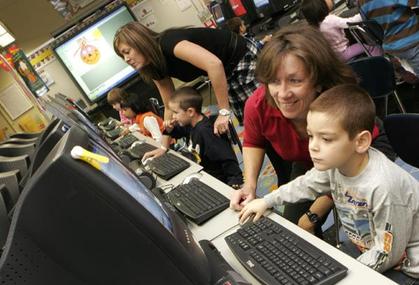
BY JESSICA LYONS
Thursday, October 26, 2006 1:58 PM CDT
A group of kindergarten students excitedly file into the technology room at P.S. 46, the Alley Pond School, and sit on a carpet in the middle of the room as they hear about how they are going to make a pumpkin on the computer. It's all part of a new technology class that was created this year.
“Every year we revise our technology goals and that was one of my goals - that I wanted to have kindergartners in computer class,” said Janet Elias, the school's technology facilitator.
This marks the first year that the school has offered technology to its kindergarten students. There are now three classes serving a total of 60 students.
Elias said that, when the class first started, the children found it difficult to use the mouse. After some “mouse aerobics,” they have learned how to do tasks such as click and scroll. They have also used Simon Says to learn parts of the computer.
Each day, the children are given a different task to do. Elias said that, by the end of the class, the goal is for them to produce the product and be able to follow the steps that she demonstrates at the beginning of the period.
After learning how to make circles in Microsoft Paint the week before, the students spent one class in October designing their own pumpkins. They are encouraged to add special touches, such as glasses or a hat.
“I like to teach the children this program early because of its simplicity and the fact that it's bundled with every version of Windows,” Elias said. “Therefore, parents do not need to go out and buy this software.”
Twin 5-year-old sisters Colleen and Claire Crinno have been exposed to computers before at home and both like to use the painting program in class.
Brain Hsiao, also 5, said that his favorite part about the computer class is making a calendar, which is done on the website www.starfall.com. The students put in the month, dates and pictures and can mark down special occasions such as birthdays.
“The kids love it, they absolutely love coming,” Elias said of how the young students have responded to the class. “I try to make it really fun and creative for them to make it a happy environment.”
Another aspect of the class teaches the students online safety. Elias said that, through pbskids.org, the children will receive online safety licenses. They will begin this part of the class after Thanksgiving.
In January, the class will begin doing more advanced work, such as learning jump-start typing, along with learning how to use other programs and do more projects.
Elias said that, since technology is everywhere, it is good to start familiarizing children with it at a young age. The students are also encouraged to help one another.
“It's important to start them so young because computers are an integral part of our lives, everybody's life,” she said. “And this is not going away.”
Along with giving children a head start when it comes to using technology, Elias said the class can also show students something about themselves.
“One thing I stress to the students is that the computer is not smart and that they are the ones that are smart. I teach them that the computer can not think like they can or be creative like them,” Elias said.
“I teach them that the computer can only follow a list of instructions and do as it's told and they are the ones telling it what to do. They are the real intelligence behind the computer.”
Thursday, October 26, 2006 1:58 PM CDT
A group of kindergarten students excitedly file into the technology room at P.S. 46, the Alley Pond School, and sit on a carpet in the middle of the room as they hear about how they are going to make a pumpkin on the computer. It's all part of a new technology class that was created this year.
“Every year we revise our technology goals and that was one of my goals - that I wanted to have kindergartners in computer class,” said Janet Elias, the school's technology facilitator.
This marks the first year that the school has offered technology to its kindergarten students. There are now three classes serving a total of 60 students.
Elias said that, when the class first started, the children found it difficult to use the mouse. After some “mouse aerobics,” they have learned how to do tasks such as click and scroll. They have also used Simon Says to learn parts of the computer.
Each day, the children are given a different task to do. Elias said that, by the end of the class, the goal is for them to produce the product and be able to follow the steps that she demonstrates at the beginning of the period.
After learning how to make circles in Microsoft Paint the week before, the students spent one class in October designing their own pumpkins. They are encouraged to add special touches, such as glasses or a hat.
“I like to teach the children this program early because of its simplicity and the fact that it's bundled with every version of Windows,” Elias said. “Therefore, parents do not need to go out and buy this software.”
Twin 5-year-old sisters Colleen and Claire Crinno have been exposed to computers before at home and both like to use the painting program in class.
Brain Hsiao, also 5, said that his favorite part about the computer class is making a calendar, which is done on the website www.starfall.com. The students put in the month, dates and pictures and can mark down special occasions such as birthdays.
“The kids love it, they absolutely love coming,” Elias said of how the young students have responded to the class. “I try to make it really fun and creative for them to make it a happy environment.”
Another aspect of the class teaches the students online safety. Elias said that, through pbskids.org, the children will receive online safety licenses. They will begin this part of the class after Thanksgiving.
In January, the class will begin doing more advanced work, such as learning jump-start typing, along with learning how to use other programs and do more projects.
Elias said that, since technology is everywhere, it is good to start familiarizing children with it at a young age. The students are also encouraged to help one another.
“It's important to start them so young because computers are an integral part of our lives, everybody's life,” she said. “And this is not going away.”
Along with giving children a head start when it comes to using technology, Elias said the class can also show students something about themselves.
“One thing I stress to the students is that the computer is not smart and that they are the ones that are smart. I teach them that the computer can not think like they can or be creative like them,” Elias said.
“I teach them that the computer can only follow a list of instructions and do as it's told and they are the ones telling it what to do. They are the real intelligence behind the computer.”
THE QUEENS COURIER
Journalism Class in Elementary School
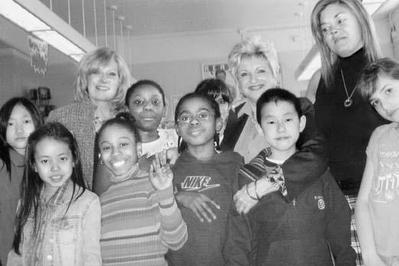
BY ZACHARY BRAZILLER
Thursday, April 6, 2006 3:42 PM CDT
As part of the Renzulli Schoolwide Enrichment Program, the next generation of writers is alive and well at P.S. 46 Alley Pond School in Bayside.
The program, called Its News to Me, includes 20 students, ranging from third to fifth graders, taking on different jobs of the newspaper business, from writing, editing, reporting, publishing, and even getting advertising. Their paper is called The Alley Pond Press. “The Children learn the actual workings of how to do a job, how to put together a newspaper,” P.S. 46 Principal Marsha Goldberg said.
“I chose Its New to Me because I like writing and I want to be an author when I grow up,” third grader Brianna Cea said.
For their first assignment, two students were asked to interview the new staff at the school. They had to prepare questions, arrange an interview, write it up, and then edit the story themselves.
The Renzulli Schoolwide Enrichment Program isn’t limited to journalism at the Alley Pond School. They have 18 different classes, such as Paint Like the Masters, where children choose one of their favorite artists and imitate their work; The Extreme Hall Makeover, which allows students to redesign the school’s third floor; and Can You Hear Me Now, a sign language initiative, and many others.

